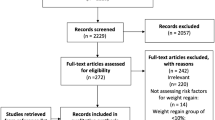Abstract
Background
Recently, two genes, peroxisome proliferator activated receptor gamma (PPARγ) and ectonucleotide pyrophosphate phosphodiesterase (ENPP1), have been localized and associated with diabetes and obesity. This report hypothesizes that there is a correlation between the genetic expression of ENPP1 and PPARγ from gastrointestinal tissue and body mass index (BMI).
Methods
Preoperative demographic data were collected from 16 severely morbidly obese patients. Extraneous gastrointestinal tissue was obtained during laparoscopic gastric bypass and gastric banding procedures. The tissue was snap frozen in liquid nitrogen. Initially, RNA extraction was performed on the tissue, followed by reverse transcription using appropriate primers and controls. Subsequently, the samples were subjected to quantitative polymerase chain reaction (PCR). Preoperative demographic data were analyzed for their influence on ENPP1 and PPARγ expression using multivariate analysis and logistic regression models.
Results
Expression of PPARγ and ENPP1 was found in all samples. There was a higher level of PPARγ expression in omental tissue than in enteric tissue. There was no significant difference in the expression of ENPP1 among the different tissue types. The relative level of PPARγ expression in small bowel and gastric tissue was found to be inversely proportional to body mass index (BMI) using linear regression analysis (p = 0.01; r 2 = 0.586). Similarly, PPARγ expression from omental tissue showed an inverse relationship with BMI (p = 0.04; r 2 = 0.576). The levels of ENPP1 expression did not show a correlation with BMI (p = 0.25).
Conclusion
The results suggest that increasing obesity correlates with a decrease in PPARγ expression. This decrease may induce dysfunctional adipocyte differentiation, maturation, and function, leading to diabetes and the metabolic syndrome. Similarly, the increased volume of adipose tissue may lead to a downregulation of PPARγ. The lack of correlation between ENPP1 and BMI may suggest that glucose metabolism is more complex than lipid metabolism. Further evaluation is warranted to establish metabolic pathways for glucose and lipid biomarkers.


Similar content being viewed by others
References
Nadler ST, Attie AD (2001) Please pass the chips: genomic insights into obesity and diabetes. J Nutr 131: 2078–2081
Tontonoz P, Hu E, Graves RA, Budavari AB, Spiegelman BM (1994) mPPARγ2: tissue site-specific regulator of adipocyte enhancer. Genes Dev 8: 1224–1234
Wilson TM, Lambert MH, Kliewer SA (2001) Peroxisome proliferator-activated receptor gamma and metabolic disease. Annu Rev Biochem 70: 341–367
Chinetti G, Fruchart JC, Staels B (2000) Peroxisome proliferator-activated receptors (PPARs): nuclear receptors at the crossroads between lipid metabolism and inflammation. Inflamm Res 49: 497–505
Miyazaki Y, Glass L, Triplitt C, et al. (2001) Effect of rosiglitazone on glucose and nonesterified fatty acid metabolism in type 2 diabetic patients. Diabetologia 44: 2210–2219
Miyazaki Y, Mahankali A, Matsuda M, et al. (2002) Effect of pioglitazone on abdominal fat distribution and insulin sensitivity in type 2 diabetic patients. J Clin Endocrinol Metab 87: 2784–2791
He A, Barak Y, Hevener A, et al. (2003) Adipose-specific peroxisome proliferator-activated receptor gamma knockout causes insulin resistance in fat and liver but not muscle. Proc Natl Acad Sci USA 100: 15712–15717
Hevener AL, He W, Barak Y, et al. (2003) Muscle- specific PPAR-G deletion causes insulin resistance. Nat Med 9: 1491–1497
Braissant O, Foufelle F, Scotto C, Dauca M, Wahli W (1996) Differential expression of peroxisome proliferator-activated receptors (PPARs): tissue distribution of PPAR-γ, β, and γ in the adult rat. Endocrinology 137: 354–366
Meyre D, Bouatia-Naji N, Tounian A, Samson C, Lecoeur C, Vatin V, Ghoussaini M, Wachter C, Hercberg S, Charpentier G, Patsch W, Pattou F, Charles MA, Tounian P, Clement K, Jouret B, Weill J, Maddux BA, Goldfine ID, Walley A, Boutin P, Dina C, Froguel P (2005) Variants of ENPP1 are associated with childhood and adult obesity and increase the risk of glucose intolerance and type 2 diabetes. Nat Genet 37: 863–867
Flegal KM, Carroll MD, Ogden CL, Johnson CL (2002) Prevalence and trends in obesity among U.S. adults, 1999–2000. JAMA 288: 1723–1727
Blanquart C, Barbier O, Fruchart JC, Staels B, Glineur C (2003) Peroxisome proliferator-activated receptors: regulation of transcriptional activities and roles in inflammation. J Steroid Bio Mol Biol 85: 267–273
Maddux BA, Sbraccia P, Kumakura S, Sasson S, Youngren J, Fisher A, Spencer S, Grupe A, Henzel W, Stewart TA, et al. (1995) Membrane glycoprotein PC-1 and insulin resistance in non–insulin-dependent diabetes mellitus. Nature 373: 448–451
Maddux BA, Goldfine ID (2000) Membrane glycoprotein PC-1inhibition of insulin receptor function occurs via direct interaction with the receptor alpha-subunit. Diabetes 49: 13–19
Weill J, Vanderbecken S, Froguel P (2004) Understanding the rising incidence of type 2 diabetes in adolescence. Arch Dis Child 89: 502–504
Shimomura I, Bashmakov Y, Horton JD (1999) Increased levels of nuclear SREBP-1c associated with fatty livers in two mouse models of diabetes mellitus. J Biol Chem 274: 30028–30032
NIH Conference (1991) Gastrointestinal surgery for severe obesity. Consensus Development Conference Panel. Ann Intern Med 115: 956–961
Pories WJ, MacDonald KG Jr, Flickinger EG, et al. (1992) Is type II diabetes mellitus (NIDDM) a surgical disease. Ann Surg 215: 633–642
Jan JC, Hong D, Pereira N, Patterson EJ (2005) Laparoscopic adjustable gastric banding versus laparoscopic gastric bypass for morbid obesity: a single-institution comparison study of early results. J Gastrointest Surg 9: 30–41
Schena M, Shalon D, Heller R, Chai A, Brown PO, Davis RW (1996) Parallel human genome analysis: microarray-based expression monitoring of 1000 genes. Proc Natl Acad Sci USA 93: 10614–10619
Schena M, Shalon D, Davis RW, Brown PO (1995) Quantitative monitoring of gene expression patterns with a complementary DNA microarray. Science 270: 467–470
Ford MD (2001) Clinical toxicology, 1st ed. W.B. Saunders, Philadelphia, PA, pp 427–429
Author information
Authors and Affiliations
Corresponding author
Rights and permissions
About this article
Cite this article
Brody, F., Hill, S., Celenski, S. et al. Expression of ectonucleotide pyrophosphate phosphodiesterase and peroxisome proliferator activated receptor gamma in morbidly obese patients. Surg Endosc 21, 941–944 (2007). https://doi.org/10.1007/s00464-006-9098-3
Received:
Accepted:
Published:
Issue Date:
DOI: https://doi.org/10.1007/s00464-006-9098-3




